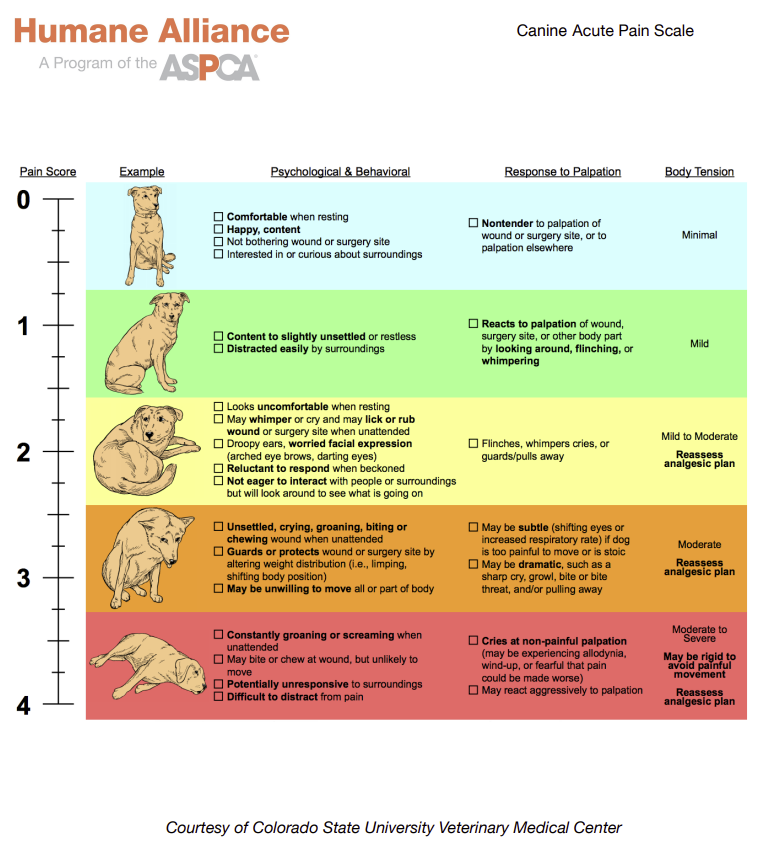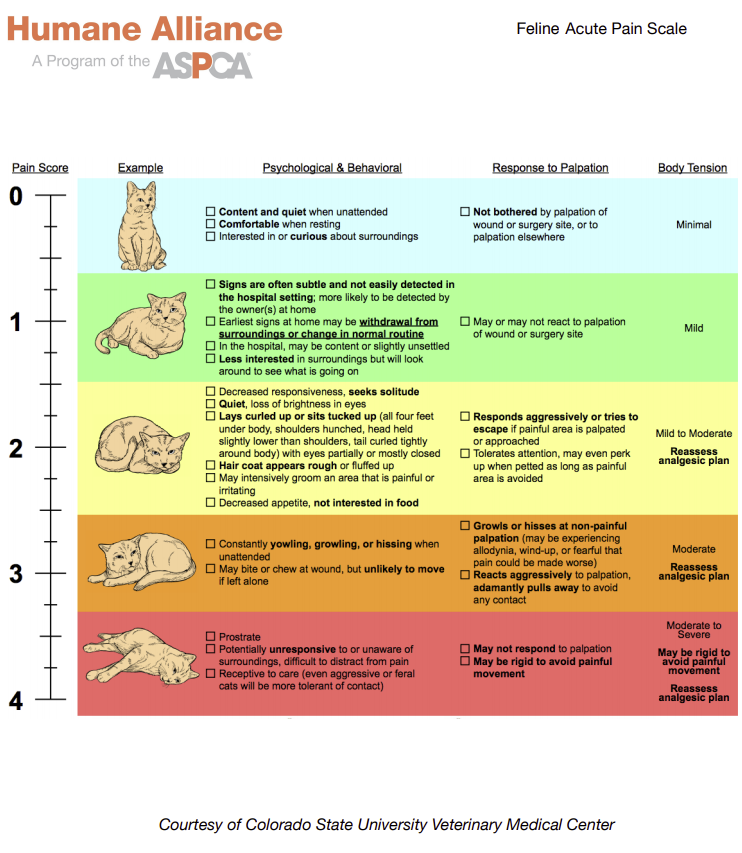Pain is something that we as doctors know is universal to humans and pets alike. But the difference with our pets is that it can be hard for them to tell us they are in pain, and sometimes their signs of pain are easy to miss. Typical signs of pain that a client may report range from more obvious signs such as sudden vocalization and aggression to more subtle signs such as loss of appetite, decreased activity, difficulty standing after lying down or even trouble going up and down stairs. As veterinary professionals we group these clinical signs into either acute or chronic pain.
First, let’s talk about acute pain. Acute pain is generally obvious with trauma and post-surgical pain being the most common types encountered in veterinary practices. Colorado State University Veterinary Medical Center has created an acute pain scale for dogs and cats. These tools are extremely helpful to quantify a pet’s pain score and determine the best course of treatment.


On the flipside, chronic pain is much more subtle; common causes include osteoarthritis, intervertebral disc disease, and cancer. Due to many of these diseases being life-long and progressive once diagnosed, a discussion of quality of life often accompanies chronic pain treatment plans. To compound matters, the level of chronic pain can be difficult to assess when a pet is in the hospital, so veterinarians must utilize a tool referred to as an owner’s assessment of activities of daily living. There are a number of these tools available for veterinarians to use in determining the degree of chronic pain a pet is experiencing. The following is a description of a few of these tools:
- The University of Pennsylvania’s Canine Brief Pain Inventory: This inventory was developed by Dr. Dorothy Cimino Brown to allow owners to rate their dog’s pain and the degree with which it interferes with function. Using two dimensions, pain severity and interference with daily functions, this tool helps dictate the severity of chronic pain.
- Helsinki Chronic Pain Index: This questionnaire will help determine the degree of pain caused by osteoarthritis. It explores willingness to participate, and ability to move.
- Feline Musculoskeletal Pain Index: This tool was specifically designed for cats and was developed by North Carolina State College of Veterinary Medicine. You can request a copy for use from the link provided.
Given that pain can be either acute or chronic and can range from mild to severe, it’s not surprising that we often must treat pain in a variety of ways. The most common options for pain management in dogs and cats include weight management, medications, acupuncture, and physical rehabilitation.
Weight management is especially important in osteoarthritis cases as any additional weight a pet’s joints must support may dramatically increase pain, and negatively impact a pet’s quality of life. The Basic Calorie Calculator from the Ohio State University is a great tool for veterinary teams to use to determine a pet’s caloric intake for weight loss. Additionally, on the Ohio State University site, there are Body Condition Scoring charts that can be used by both the veterinary team as well as the client to determine when a dog or cat has achieved their ideal weight.
Medications that directly target the pain pathways to minimize a pet’s discomfort are often used in both acute and chronic pain cases. Depending on the type of severity of pain a pet is experiencing, several different medications can be used including opioids, NSAIDs, local anesthetics, gabapentin, and tramadol. These medications can be used either alone or in combination and can also be used alongside other modes of therapy.
For a minimally invasive option, acupuncture is a great choice. Acupuncture involves the insertion of needles at specific points where nerves and blood vessels converge. Placing needles at these specific sites, can enhance blood circulation and stimulate the nervous system thereby improving healing and reducing pain and discomfort.
Physical rehabilitation uses a variety of range of motion exercises and therapeutic massage to increase musculoskeletal strength, improve function and decrease pain. Physical therapy can be especially useful the in post-surgical care of orthopedic cases.
In summary, when managing pain in pets it is important to first determine the type and degree of pain a pet is experiencing. Once you have further defined a pet’s pain, the next step is to partner with the client on the options for pain management taking into consideration the pet’s quality of life. Communication with the client and observation of the pet’s behavior are crucial for long-term management, and can help a pet live a much longer and more comfortable life.
Source By Lora LaBranche, DVM


Hello just wanted to give you a brief heads up and let
you know a few of the pictures aren’t loading
correctly. I’m not sure why but I think its a linking issue.
I’ve tried it in two different internet browsers
and both show the same outcome.